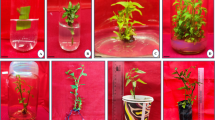Abstract
Callus cultures of 5 genotypes of S. scabra Vog. were optimally established from leaf tissue on Murashige and Skoog (MS) basal medium supplemented with 0.5–2.0 mg l-1 2, 4-Dichlorophenoxy acetic acid (2, 4-D) and 1.0–2.0 mg l-1 6-benzylaminopurine (BAP). On media containing 2, 4-D only, calli were soft, and rhizogenesis occurred on calli of 4 genotypes. Calli formed on media containing BAP only, but not with kinetin only. In the presence of 2, 4-D, BAP inhibited rhizogenesis and promoted better callus growth than kinetin. High frequency shoot induction was achieved for 3 genotypes on MS +2.0 mg l-1 BAP. Roots formed on shoots when sub-cultured on half-strenght MS without growth regulators. The form of cytokinin used in the callus induction media appeared to affect subsequent shoot organogenesis. Genotypic differences were observed for shoot organogenesis. There was some morphological variation evident among regenerants.
Similar content being viewed by others
References
Murashige T, Skoog F (1962) A revised medium for rapid growth and bioassays with tobacco tissue cultures. Physiol Plant 15:473–497
Burt RL and Miller CP (1975) Stylosanthes—a source of pasture legumes. Trop Grassl 9:117–123
Humphreys LR (1980) A Guide to better Pastures for the Tropics and Sub-tropics 4th ed. Wright Stephenson and Co, Sydney
Thomas E, King PJ, Potrykus I (1979) Improvement of crop plants via single cells in vitro: An assessment. Z Pflanzenzuchtg 82:1–30
Day PR (1980) Tissue culture methods in plant breeding. In: Ingram DS, Helgeson JP (eds) Tissue Culture Methods for Plant Pathologists. Sydney: Academic Press, 223–231
Larkin PJ, Scowcroft WR (1981) Somaclonal variation: A novel source of variability from cell culture for plant improvement. Theor Appl Genet 60:197
Flick CE, Evans DA, Sharp DR (1984) Organogenesis. In: Evans DA, Sharp WR, Ammirato PV, Yamada Y (eds) Handbook of Plant Cell Culture, Vol. 1. New York: Macmillan, pp 13–81
Scowcroft WR, Adamson JA (1976) Organogenesis from callus cultures of the legume, Stylosanthes hamata. Plant Sci Lett 7:39–42
Meijer EGM (1982) HIgh-frequency plant regeneration from hypocotyl — and leaf-derived tissue cultures of the tropical pasture legume Stylosanthes humilis. Physiol Plant 56:381–385
Meijer EGM, Broughton WJ (1981) Regeneration of whole plants from hypocotyl-, root-, and leaf-derived tissue cultures of the pasture legume Stylosanthes guianensis. Physiol Plant 52:280–284
Mroginski LA, Kartha KK (1981) Regeneration of plants from callus tissue of the forage legume Stylosanthes guianensis, Plant Sci Lett 23:245–251
Meijer EGM (1982) Shoot formation in tissue cultures of three cultivars of the tropical pasture legume Stylosanthes guianensis (Aubl.) Sw. Z Pflanzenzuchtg 89:169–172
Murashige T (1974) Plant propagation through tissue cultures. Ann Rev Plant Physiol 25:135–166
Author information
Authors and Affiliations
Rights and permissions
About this article
Cite this article
Godwin, I.D., Gordon, G.H. & Cameron, D.F. Plant regeneration from leaf-derived callus cultures of the tropical pasture legume Stylosanthes scabra Vog.. Plant Cell Tiss Organ Cult 9, 3–8 (1987). https://doi.org/10.1007/BF00046073
Issue Date:
DOI: https://doi.org/10.1007/BF00046073




